Acute Kidney Injury | Kidney Disease in Dogs & Cats

What is an acute kidney injury?
The kidneys have numerous functions that are critical to maintenance of health in the body including toxin excretion, maintenance of normal blood electrolytes and blood pressure, and ultimately production of urine. When the kidney don’t work right, the health of affected dogs and cats can become severely impacted.
Acute kidney injury (AKI) is a term that represents a broad range of sudden or acute kidney damage, ranging from mild disease that is clinically undetectable to severe life-threatening acute renal failure (ARF). Acute renal failure (ARF) is a sudden onset of potentially life-threatening kidney dysfunction and is a common disorder in dogs, cats and humans. For the purpose of this discussion, the terms AKI and ARF will be used interchangeably. Despite advances in the treatment of ARF, the death rate amongst both humans and animals remains unacceptably high. However, with appropriate care many animals can still recover.
What causes an acute kidney injury?
There are a number of underlying conditions that can lead to AKI, and ultimately to renal failure such as:
Infections
- Primary bacterial kidney infection
- Leptospirosis infection
- Lyme disease
Toxicity
- Medications such as anti-inflammatory medications
- Certain foods such as grapes/raisins in dogs
- Lily ingestion in cats
- Anti-freeze ingestion
- Severe blood pressure changes (low or high)
- Blockage of the outflow tract of the kidney (ureter)
- Severe pancreatitis (inflammation of the pancreas gland)
- Cancer of the kidney
Unfortunately, despite extensive testing, a definitive cause for development of AKI is often not found.
What are the signs of AKI in dogs and cats?
- Lethargy
- Vomiting
- Diarrhea
- Abdominal pain
- Reduced appetite
- Urinating large amounts (sometimes followed by a decline in urine output)
In AKI, clinical signs typically have a rapid onset in a dog or cat that was previously healthy. Animals with longer standing chronic kidney disease (CKD) can also develop an acute injury; in these cases, owners will likely note a sudden worsening of clinical signs. For example, if an animal with previously diagnosed CKD develops a kidney infection, they may develop significant lethargy, vomiting and decreased appetite.
How is AKI diagnosed?
A veterinarian will diagnose suspected AKI based on:
- Patient history
- Physical examination
- Blood work evaluation
- Urine testing (urinalysis and urine culture)
- Abdominal ultrasound
- Blood pressure measurement
- Inflammatory or infectious disease testing (in certain cases)
During the diagnostic workup, it is critical for your veterinarian to determine if an animal is affected with AKI, longer standing chronic kidney disease or a combination of both, as prognoses can be very different (this can sometimes be difficult to
distinguish).
As above, patients with AKI will usually have a sudden onset of abnormal clinical signs and no history of significant weight loss (unless there are other underlying disease processes). On physical examination, patients
may exhibit pain in the area of their kidneys.
In a patient with AKI, blood work evaluation will show elevated blood urea nitrogen (BUN) and creatinine values, which are the most commonly used markers for diagnosis of kidney dysfunction.
Once elevated BUN and creatinine are found, your veterinarian will use the comprehensive evaluation to determine if chronic disease is present, to determine treatment plans and to help find a possible underlying cause for the damage.
What is the basic treatment for AKI?
If an underlying cause such infection or blockage is diagnosed, then it should be treated. Once the initial cause is being treated or if no underlying cause is found (which is often the case), treatment is aimed at supportive care which often includes the following:
- Intravenous (IV) fluids
- Treatment of blood pressure abnormalities
- Anti-nausea medications
- Gastrointestinal protectants
- Pain relievers
Your veterinarian will use bloodwork to ensure maintenance of body electrolytes and acid-base status.
Does my pet need dialysis?
In severe ARF, urine production can decrease significantly or stop altogether. In these patients, dialysis or blood purification is often needed to keep patients stable while the kidneys are given time to heal. In general, the primary indications for dialysis to be started are:
- Severely elevated kidney values in a sick patient (especially when no underlying cause is found)
- Life-threatening electrolyte abnormalities
- Overhydration due to fluid administration and lack of urine production
The goal of dialysis is to stabilize patients while the kidneys recover.
What is the prognosis for AKI?
Animals with AKI can have variable outcomes, depending upon the cause and severity of injury and the cause of AKI (when known). In some patients, medical management will give time for kidneys to heal and patients may be discharged from the hospital with kidney values that are within normal ranges. Other animals may recover but develop clinically significant permanent damage that leads to CKD. Finally, some patients may not recover or may require life-long dialysis to maintain quality of life; this is not commonly performed in veterinary medicine. It is important to note that the degree of elevation in kidney values does not always correlate with outcome. With appropriate care, many patients that initially have significant dysfunction can have good outcomes.
...
Listen to an episode on Chronic kidney disease in cats from Morris Animal Foundation's Fresh Scoop Podcast!
Edited By:
Paige Mackey, DVM, MPH, DACVIM (SAIM)
April, 2020
Articles by Specialty
- Cardiology (19)
- Large Animal Internal Medicine (23)
- Neurology (17)
- Oncology (21)
- Small Animal Internal Medicine (29)
Articles by Animal
- Cats (35)
- Dogs (52)
- Farm Animals (5)
- Horses (12)
